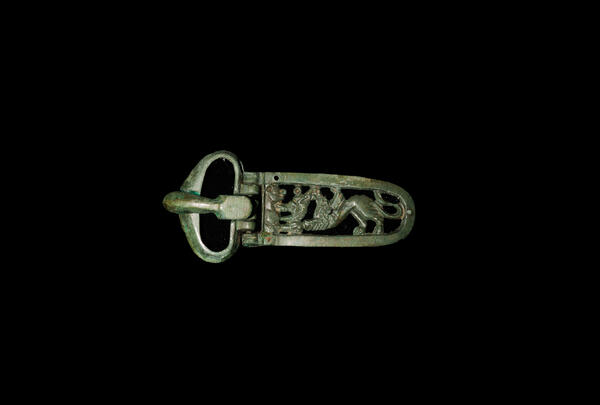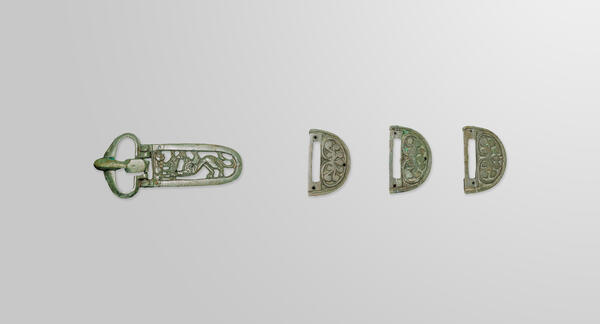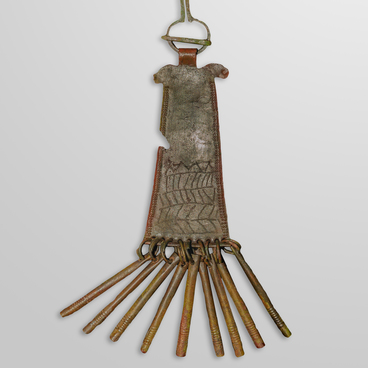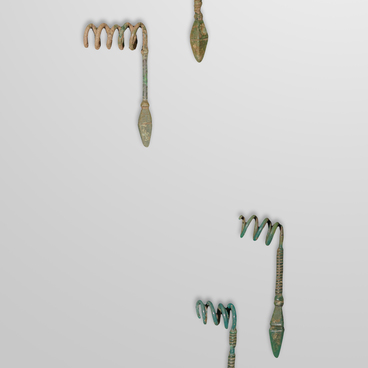The belt buckle with an image of a winged animal of prey is presumably an imported item. It was found in the Starobadikovo II burial ground in Zubovo-Polyansky district of the Republic of Mordovia. The burial ground dates from the 7th to the early 9th century and is located north of the village of Staroe Badikovo, on the left bank of the Vad River. The archaeologists Viktor Shitov and Ivan Peterburgsky examined more than 300 burials. The finds are represented by tools, weapons, clay molded vessels. Female burials featured numerous ornaments, while male warriors’ ones contained large silver clasps. The Ancient Mordovian identity of the burial site is determined by finds of numerous temple pendants with a spiral and a bi-pyramidal weight, syulgams, and puloker hair decorations. The archaeologists also found imported objects in the burials, including the bronze clasp decorated with red enamel and this buckle with an image of a winged beast of prey.
In the middle of the 1st millennium AD the history of the ancient Mordovian tribes was connected with the process of the movement of peoples, which is known as the “Great Migration”. In the 7th century the Bulgar tribes appeared in the Middle Volga region. Settling on the Volga, they became the eastern neighbors of the Mordovians. At the same time, the Alanian population of the Northern Caucasus, pressed by the Arab conquerors, moved to the upper reaches of the Seversky Donets, Oskol and Don, to the areas bordering the lands of the Tsna Mordovians.
The element of the belt set has a rectangular rounded shape on one side and a massive vertically extended clasp with a beak-shaped curved tongue on the other. In the wide edging of the buckle there is a slit image of an animal of prey attacking another animal. The beast of prey, leaning on its hind legs, is tormenting its prey. The paws show bird’s claws; the upraised lion’s tail, ending in a tassel, is curved in a wave-like manner. The wing has diagonal lines and strokes. The mouth of the beast is ajar, the neck is curved, and the body is covered with depressed diagonal strokes and dots. The flattened ear and eye of the fantastic predator are clearly visible.
The scene of torment depicted on the belt buckle is fully repeated on similar items in the collection of the State Historical Museum in Moscow.
In the middle of the 1st millennium AD the history of the ancient Mordovian tribes was connected with the process of the movement of peoples, which is known as the “Great Migration”. In the 7th century the Bulgar tribes appeared in the Middle Volga region. Settling on the Volga, they became the eastern neighbors of the Mordovians. At the same time, the Alanian population of the Northern Caucasus, pressed by the Arab conquerors, moved to the upper reaches of the Seversky Donets, Oskol and Don, to the areas bordering the lands of the Tsna Mordovians.
The element of the belt set has a rectangular rounded shape on one side and a massive vertically extended clasp with a beak-shaped curved tongue on the other. In the wide edging of the buckle there is a slit image of an animal of prey attacking another animal. The beast of prey, leaning on its hind legs, is tormenting its prey. The paws show bird’s claws; the upraised lion’s tail, ending in a tassel, is curved in a wave-like manner. The wing has diagonal lines and strokes. The mouth of the beast is ajar, the neck is curved, and the body is covered with depressed diagonal strokes and dots. The flattened ear and eye of the fantastic predator are clearly visible.
The scene of torment depicted on the belt buckle is fully repeated on similar items in the collection of the State Historical Museum in Moscow.






